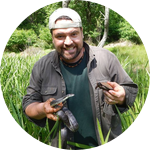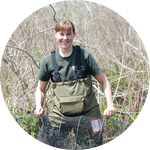About This Project
The Eastern Hellbender is a large (up to 29 inches!) salamander that has declined throughout its range. Numerous threats face the species including a lack of nesting habitat in some streams and rivers, often due to siltation. Effective conservation is also hampered by a poor understanding of distribution in Pennsylvania. This project will create artificial refugia (hiding spots) called nesting boxes that can be used to both detect Hellbenders in the wild and offer nesting habitat.
Ask the Scientists
Join The DiscussionWhat is the context of this research?
This project will investigate whether nest boxes for the Eastern Hellbender will be utilized for nesting and as a search method. Two sets of sites will be selected: those with known Hellbender colonies for reference and control, and those sites that historically had Hellbender observations. Nesting boxes have been utilized by workers in several states (Briggler and Atkinson 2012, Messerman 2014 https://core.ac.uk/download/pd...). Standard survey technique includes the use of peavey bars to wrench heavy rocks from the bottom of streams to look for Hellbenders, likely harming habitats. We are hopeful non-invasive nesting boxes can be used as an alternative sampling method. Nesting boxes have not been previously used in Pennsylvania, making this a first for the state.
What is the significance of this project?
The project is located in Commonwealth of Pennsylvania, a state that has what may be the largest Eastern Hellbender range in the Northeastern United States. Unfortunately, studies of historical (records over 30 years old) stream and river drainages are almost non-existent. This significantly impacts conservation decision-making in a negative way. Standard survey techniques are invasive, often include the wrenching of suitable rocks (specifically oriented large, flat rocks on the stream floor), and may damage the very habitat that researchers are trying to protect. Nesting boxes may allow for non-invasive surveying for the Hellbender in Pennsylvania. Additionally, the inclusion of volunteers from the local sampling areas foster a sense of community and interest in this rare salamander.
What are the goals of the project?
The main goals of this project are to understand the distribution of Pennsylvania Eastern Hellbenders, and to test the efficacy of non-invasive surveying. We will create 100 nesting boxes for the spring of 2017. A statistically significant number of sites will be selected, both reference sites and historical sites. Reference sites have been previously sampled and have accompanying abundance data. Boxes will be set after spring rains and checked bi-monthly (via a small door on the box top) from June through November for two years. Each captured Hellbender will be humanely marked, measured, photographed, and released at the spot of capture. This project will also increase opportunities for local stakeholders (citizen-scientists) to engage in science and conservation.
Budget
The nesting box budget item allows for the creation of a nesting box mold, the fabrication of the boxes out concrete, and non-toxic finishing. These costs are estimated at $30 per box. Travel (mileage at annual IRS mileage rate) will allow staff to travel with volunteers to sampling sites, some of which are relatively remote and situated in rural landscapes.
Endorsed by
Meet the Team
Affiliates
Affiliates
Affiliates
Team Bio
The Mid-Atlantic Center for Herpetology and Conservation (MACHAC) is a non-profit organization dedicated to the conservation and study of amphibians and reptiles by a staff professional herpetologists and ecologists in the Northeastern United States. Major MACHAC projects include the study and recovery of state and federally-listed amphibians and reptiles. MACHAC believes inclusion of citizen-scientists is vital, as exampled by the much-lauded PARS project (paherpsurvey.org).
Brandon Ruhe
My earliest memories all include snakes! My lifelong passion for amphibians and reptiles led to keen interests in biogeography, conservation planning, and studies of rare and endangered species. Often, this type of work is conducted in a vacuum with like-minded professionals, but recent years have brought the realization that all stakeholders need to experience the wonders of nature and be exposed to the oft-feared amphibians and reptiles that inhabit the wild places and dark spaces of our surroundings. Believing such, our organization conducts both traditional conservation/research projects and extensive citizen-science projects.
Jason Poston
Hailing from South Carolina my interest and passion in my youth was primarily reptiles. In 2004 I moved to Pennsylvania where that passion started to take a turn towards amphibians, primarily salamanders. This turned into the creation of herp education and outreach websites, starting in 2004, since my background also includes web development, web design and database administration. A few years later I joined the MACHAC team after I started working on an Atlas project, Pennsylvania Herpetology Education and Resource Project that merged with The Pennsylvania Amphibian and Reptile Survey (PARS), the official state Amphibian and Reptile Atlas project of Pennsylvania.
Lori Erb
Salamanders have always been a passion of mine. Much of my early years were spent catching salamanders, snakes and frogs along a creek near my childhood home. During my graduate work, I studied a population of spotted salamanders. It wasn’t until after graduation that my intense enthusiasm for turtles began to grow. In more recent years, I’ve led volunteer surveys to monitor turtle populations (citizen science). I’m looking forward to using these same skills to monitor hellbender populations. Our organization is dedicated to performing research in an ecologically sustainable way and this project is a natural extension of previous work.
Project Backers
- 7Backers
- 3%Funded
- $105Total Donations
- $15.00Average Donation




